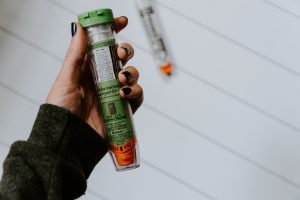Self-Injection Medication Safety
Author: Michele, Registered Nurse
Medicines come in many different forms. Many people are used to taking pills and other oral medication at home and visiting their doctor for injections. However, self-injected medications are commonly used for a number of different conditions, including diabetes, fertility treatments, growth hormone deficiency and others. Self-injections are a safe, effective way for you to take your medicine. At Hy-Vee Pharmacy Solutions (HPS) we guide patients through self-injections every day. Here are some of our self-injection medication safety tips.
Safely Administering Self-Injection Medication
Your doctor or nurse will offer detailed instructions about how to safely and effectively administer your medication at your office visit. Be sure to follow the guidelines provided. If you have any questions, don’t hesitate to ask your doctor, nurse or your HPS pharmacist.
Understand Subcutaneous Injections vs. Intramuscular Injections
If you are prescribed a self-injected medication, it may be subcutaneous or intramuscular. Subcutaneous injections are a way to deliver medication under your skin, into the layer between your skin and your muscle. Intramuscular injections deliver medication into your muscle, where it’s absorbed into the bloodstream. Whether your medication requires subcutaneous or intramuscular injections, your doctor will provide detailed instructions on how to administer it.
If you’re an HPS patient, our pharmacists will review those instructions with you to make sure you are able to administer your injection safely and successfully. Many medication manufacturers have step-by-step instructions or videos on their website that will walk you through self-injection if you need additional guidance. Ask a member of your HPS health care team to help you find these sites.
Know Where to Inject Your Medication
Know where to inject your medication to maximize comfort and effectiveness. Common injection sites include the abdomen, the upper arm and the upper thigh. These areas are easy for you to reach. Certain self-injection medications will have you pinch your skin before injecting the medication to make the process easier. If that is the case, your abdomen, upper arm and thigh usually have enough skin to pinch before you self-inject your medicine. You should also examine the injection site to make sure your skin is healthy.
Know Which Supplies to Use
There are different ways to administer self-injections, depending on your prescription. Some medicines come in a pre-filled auto-injector pen. These devices are often easy to administer with just a click of a button. Another option is a syringe with a needle. A typical syringe has three parts: a needle, a barrel to hold medication and a plunger to push the medicine through the needle. Your syringe may come pre-filled or you may have to fill the correct dose yourself. If necessary, you will learn to properly draw up the medication with a syringe.
Practice Self-Injection
Your doctor or nurse will teach you how to prepare and administer your self-injection medication. During that training, you may practice self-injection with their supervision. If you would like additional practice, ask your HPS health care team about other in-home training options.
Train a Caregiver
You may want to include a friend or family member for your self-injection training. This person can help remind you to inject your medicine if you forget or administer it for you if you are unable to inject yourself for any reason. A caregiver can also be a great source of emotional support during the self-injection process.
Practice Good Hygiene
When preparing to give your injection, always wash your hands first with antibacterial soap and warm water, making sure to scrub your hands for at least 20 seconds. It’s important to wash away any dirt or grime with water, instead of just cleansing with hand sanitizer. Dry your hands with a clean paper towel instead of a cloth one to avoid germs. Do not touch the trashcan or other surfaces in between hand washing and medication administration.
In addition to washing your hands, clean the skin where you will inject the medicine with an alcohol swab. Wipe the surface for several seconds and let it air dry. Do not blow on your skin to dry it. Once the area is dry, you may safely perform your self-injection.
Alternate Injection Sites
For a more comfortable self-injection experience, it’s best to perform your self-injection on healthy skin. Avoid injecting where there’s already a bruise or other irritation. You may also want to stay away from areas with scars or stretch marks to improve absorption. Make sure to rotate sites where you self-inject your medication. It can be helpful to use a calendar to help keep track of which sites you have used.
Proper Waste Disposal
Be sure to dispose of your self-injection equipment properly. Your doctor will provide specific guidelines but as a general rule, needles should be placed in a medical sharps container or another puncture-proof container after your injection. Placing sharp items in a puncture-proof container will help prevent accidental needle sticks. Some medication manufacturers provide sharps containers for your use. The website SafeNeedleDisposal.org help you find local options for properly disposing of used sharps materials.
If you have questions or concerns about your self-injection medication, Hy-Vee Pharmacy Solutions (HPS) is available 24 hours, 7 days a week to answer all your questions.
